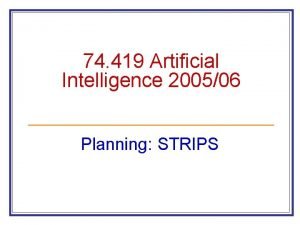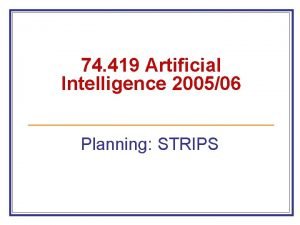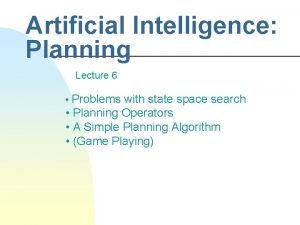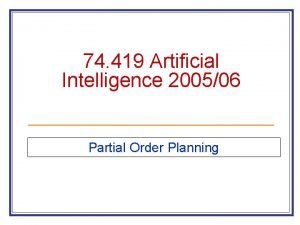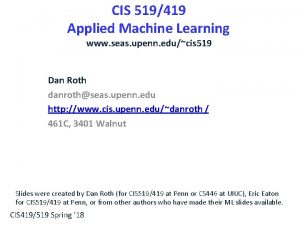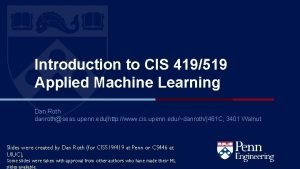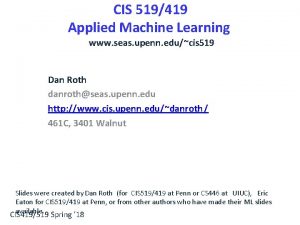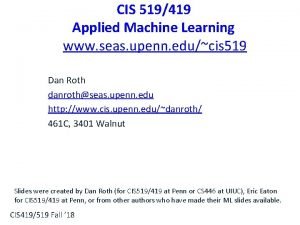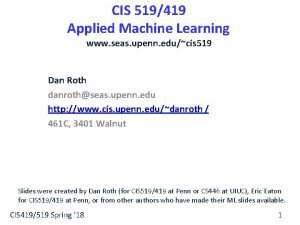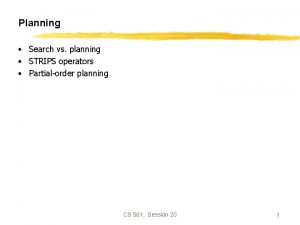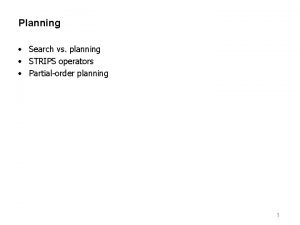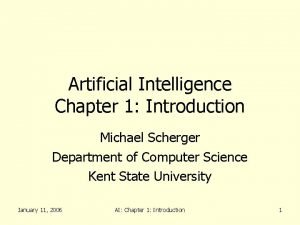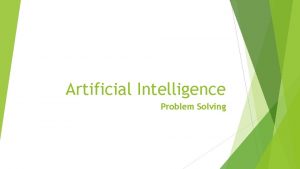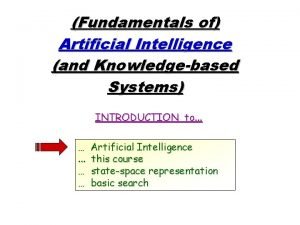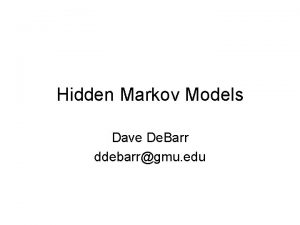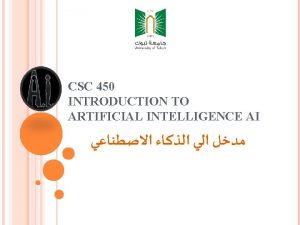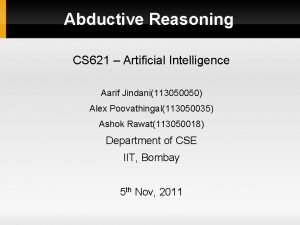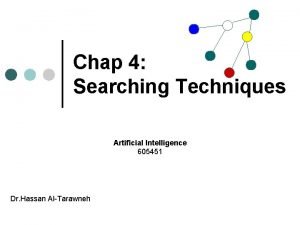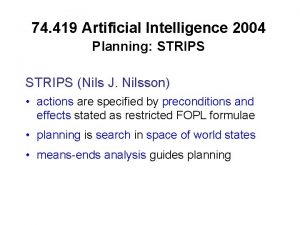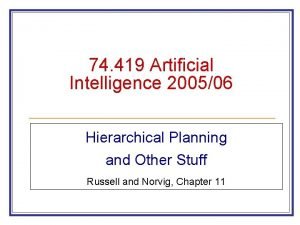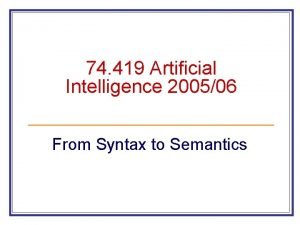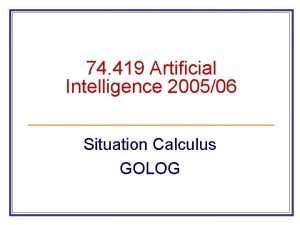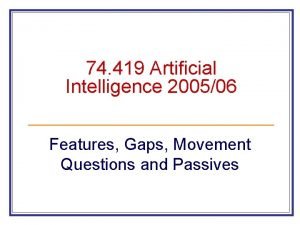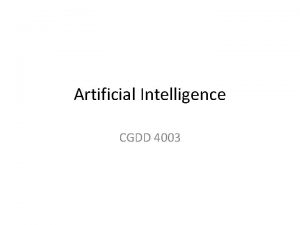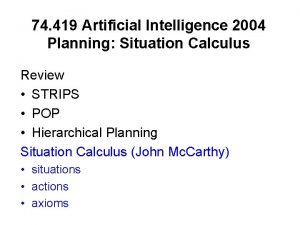74 419 Artificial Intelligence 200506 Planning STRIPS Planning

























- Slides: 25

74. 419 Artificial Intelligence 2005/06 Planning: STRIPS

Planning: STRIPS (Nils J. Nilsson) n actions are specified by preconditions and effects stated as restricted FOPL formulae n planning is search in space of world states n means-ends analysis guides planning n

STRIPS - Essence A state in STRIPS consists of a set of formulae describing the current world state. Planning is search through the space of world states, using actions as operators to generate the search space. Actions connect ‘before’ and ‘after’ world states Before and after states are described using only ground literals (conjunction thereof) and some general axioms.

STRIPS - Actions 1 § Actions are described by preconditions and effects (conjunctions of literals). § Effects are split into an ADD-list and a DELETE-list: § the ADD-list contains every new formula to be added to the current state as result of the action § the DELETE-list contains all formulae to be deleted from the current state as result of the action Note: ADD- and DELETE-lists explicitly specify what becomes true and what becomes false after an action. Thus, the state is carried along, just with necessary changes made. This circumvents the Frame Problem.

STRIPS – Example Actions in STRIPS are described as schemata with variables which are instantiated during planning ( unification). A Example: move (x, y, z) precondition: delete-list: add-list: B C Table on (x, y) clear (x) clear (z), on (x, y) on (x, z), clear (y), clear (Table) in case z=Table

STRIPS - Actions 2 Actions are described by preconditions and effects (conjunctions of positive ground literals). Effects are split into an ADD-list and a DELETE-list. An action can be applied in a state, if its preconditions are satisfied in that state. The resulting new state is determined through the effect, described as ADD- and DELETE-lists.

STRIPS – Example: move (x, y, z) precondition: delete-list: add-list: A B C Table on (x, y) clear (x) clear (z), on (x, y) on (x, z), clear (y), clear (Table) in case z=Table move (A, B, C) initial world state: on (A, B) clear (A) clear (C)

STRIPS – Example: move (x, y, z) precondition: delete-list: add-list: A B C Table on (x, y) clear (x) clear (z), on (x, y) on (x, z), clear (y), clear (Table) Planning find action-operator which achieves goal-state initial world state: on (A, B) clear (A) clear (C) goal state: on (A, C) B Table A C

STRIPS – Example A B C Table move (x, y, z): has on(x, z) in delete-list instantiate with x=A, z=C precondition: on (A, y) clear (A) clear (C) delete-list: clear (C), on (A, y) add-list: on (A, C), clear (y), clear (Table) Planning match action-description with current world state: initial world state: on (A, B) clear (A) clear (C) instantiate y=B; done goal state: on (A, C)

STRIPS – Planning as Search Planning is similar to theorem proving in Prolog. Plan = sequence of action-operators defines a path from a start-state to a goal-state. Planning can be performed • forward (from start state to goal state) progression planning • backward (from goal to start) regression planning Planning recursively - for each achieved sub-goal

STRIPS – Planning as Search Forward planning: Start with the initial state (current world state). Select actions whose preconditions match with the current state description (before-action state) through unification. Apply actions to the current world state. Generate possible follow-states (after-action states) according to the add and delete lists of the action description. Repeat for every generated new world state. Stop when a state is generated which includes the goal formula.

STRIPS – Planning as Search means-ends analysis Reduce the difference between the start state and the goal state Choose action-operators which generate literals of the goal-state description. Recursively generate action sequence (=plan) by trying to fulfill preconditions of chosen actions, until they are finally grounded in the start-state, i. e. match with literals of the start-state.

STRIPS – Planning as Search Backward planning: Start with a given goal state description. Check unsatisfied (pre)conditions of the goal description. Select and apply actions which have those conditions as effects. Proceed in the same way backwards, trying to fulfill preconditions of each new action by recursively choosing actions which achieve those preconditions. Stop when the precondition is part of the initital state, and thus a sequence of actions is found leading from the initial state to the goal state.

STRIPS – Problems Sussman Anomaly In the process of achieving a new sub-goal during the planning process, STRIPS might reverse an effect it had already achieved. Solution Approach: Don't do that! Perform backward search. Just look for conditions to achieve, and do not delete anything which is in an achieved goal or sub-goal ( goals are conjunctions of literals; deleting a part of this, would make the complete goal formula false).

Planning - Problems Frame-Problem specify everything which remains stable computationally very expensive Approach: successor-state axioms; STRIPS Qualification-Problem specify all preconditions to an action difficult to include every possible precondition Approach: non-monotonic reasoning with defaults Ramification-Problem considering side-effects of actions conflict between effects and frames Approach: integrate TMS

Resource Constraints in Planning n n n Resources n physical quantities, e. g. money, fluids etc. n time Integrate Measures into Action Description and Planning n representation of physical quantities and reasoning / calculation, e. g. for buy-action: effect: cash : = cash – price (x) n time system / time logic, e. g. go-to-action: effect: time : = time + 30 (Minutes) Backtracking on Constraint Violation

ADL - Action Definition Language ADL Can be seen as extension of the STRIPS language. Contains typing of parameters (sorts). Allows explicit expression of negation. Allows equality of terms in precondition formula. Example: Fly (p: plane; from: airport; to: airport; c: cargo) precondition: at(p, to) at(c, to) in(c, p) to from effect: at(p, to) at(c, to) at(p, from) at(c, from)

STRIPS – Plan Schemata § Concrete plans can also be seen as instantiations of Plan Schemata. § Shakey was able to generalize generated concrete plans into such plan schemata. ( plan generalization, learning)

Plan Learning / Plan Abstraction Shakey generated plan schemata, so-called MACROPs (Macro-Operators), from concrete plans it had constructed earlier (i. e. “it learns plans”). The learning process is based on describing the plan in a triangle-table (preconditions and effects of sequential actions in rows, actions in columns). Then substitute constants with variables, in a kind of inverse variable binding process with unification. (substitute the same constant with one variable) Thus, an abstract plan schema is generated from the concrete plan.

ABSTRIPS - Triangle Table Generate Plan with STRIPS n Set up Triangle Table: n n left of action: precondition below action: effects (add-list) - record only literals needed by subsequent actions or as part of the goal clause. Generalization (abstraction) n Substitute constants with variables.

"effect" of start-action initial state precond. of move(A, B, Fl) effect of move(A, B, Fl) precond. of move(B, C, Fl) effect of move(B, C, Fl) precond. of finish

Generate Plan Schema Generalization (abstraction) of concrete plan. n Substitute constants with variables: n n n Fl remains Fl A x B y C z


Planning – Other Approaches Partial Order Planning Start with rough plan, and use refinement operators to work out details. Hierarchical Task Networks / Plan Decomposition Plan schemata are organized in a hierarchy. Links between nodes at different levels in this hierarchy denote a decomposition of a complex plan/action. Situation Calculus Planning as Theorem Proving. Describe situations (world states) using a situation parameter in action descriptions.

Additional References Nils J. Nilsson: Artificial Intelligence – A New Synthesis. Morgan Kaufmann, San Francisco, 1998.
 Differentiate between strips and adl
Differentiate between strips and adl Strips planning
Strips planning Planning in artificial intelligence
Planning in artificial intelligence Total order planning in artificial intelligence
Total order planning in artificial intelligence Cis 419
Cis 419 Cis 419
Cis 419 Upenn cis 519
Upenn cis 519 Upenn cis 519
Upenn cis 519 Upenn machine learning
Upenn machine learning Strips operators
Strips operators Strips planning
Strips planning Artificial intelligence chapter 1
Artificial intelligence chapter 1 Cse 571 asu
Cse 571 asu Artificial intelligence
Artificial intelligence Artificial intelligence leadership
Artificial intelligence leadership Fundamentals of artificial intelligence
Fundamentals of artificial intelligence Dr roman yampolskiy
Dr roman yampolskiy Artificial intelligence: a modern approach
Artificial intelligence: a modern approach Mobedic
Mobedic Artificial intelligence
Artificial intelligence Water jug problem using dfs
Water jug problem using dfs Augmented grammar in ai
Augmented grammar in ai Searching for solutions in artificial intelligence
Searching for solutions in artificial intelligence Abductive argument
Abductive argument 15-780 graduate artificial intelligence
15-780 graduate artificial intelligence Best for search
Best for search
